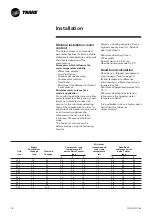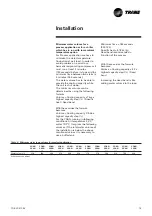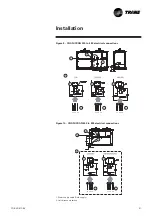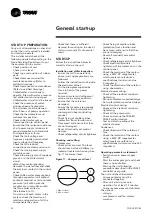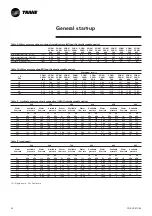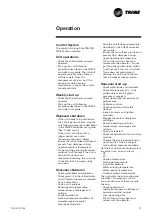
20
CG-SVX01C-E4
Water treatment
Untreated or insufficiently treated
water, if used in this unit, may cause
scale, slime or algae to accumulate
or cause erosion and corrosion.
As Trane does not know the
components used in the hydraulic
network and the quality of the water
used, we recommend the services of
a qualified water treatment
specialist.
The following materials are used in
Trane chillers heat exchangers:
- Stainless steel plates AISI 316,
1.4401 with copper brazing.
- Water piping: steel
- Water connections: brass
Trane will not accept any ability in
regards of damage due to the use of
untreated or improperly treated
water or from the use of saline or
brackish water.
If required, contact your local Trane
sales office.
Winter freeze protection
During negative ambient air
temperature chilled water piping
must be fully insulated.
Ensure that all safeties are taken to
prevent frost damage during
negative ambient air temperature.
Following system can be used:
- Electrical heater mounted on all
water piping exposed to negative
temperatures.
- Start chilled water pump during
negative ambient air temperature.
- Add ethylene glycol in the chilled
water.
- Drain water-circuit, however be
aware of corrosion process when
drained.
Electrical connections
Caution:
1. The greatest care should be taken
when cutting through passages
and installing electric wiring.
Under no circumstances should
chips of metal or cuttings of
copper or isolating material fall
into the starter panel or electric
components. Relays, contactors,
terminals and control wiring
should be covered and protected
before power supplies are
connected.
2. Install power supply cabling as
shown in wiring diagram.
Adequate cable gland should be
chosen, ensuring no foreign
bodies enter the electrical housing
or components.
Caution:
1. Cabling must comply with
standards in force. The type and
location of fuses must also comply
with standards. As a safety
measure, fuses should be visibly
installed, close to the unit.
2. Only copper wiring should be
used. Using aluminium wires can
produce galvanic corrosion and
possibly lead to superheat and
failure of connection points.
% Ethylene glycol
Brine temperature (°C)
Installation
Figure 8 - Freezing point versus ethylene
glycol percentage
1. Liquid
2. Freezing without burst effect
3. Freezing with burst effect
Expansion valves settings
In order to keep the compressor in
the operating envelope, it is
mandatory to control the superheat
suction at commissioning. It shall
reduce the compressor discharge
gas temp and increase the saturated
suction temperature, increasing by
the way the unit capacity. The rule to
reduce the suction superheat is to
loosen the expansion valve
adjustment screw. One turn
counterclockwise equals to -1°C to
-2°C superheat decrease. It is
recommended to lower the
superheat by increasing the suction
pressure by making adjustments to
the expansion valve setting prior to
attempting to lower the LP setting
parameter to avoid unit tripping on
low pressure. Make sure there is
enough subcooling. This can be
convenient for units with Ethylene
Glycol and Propylene Glycol.













